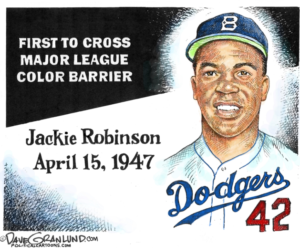 If you’ve ever doubted than a black man would be elected president of the U.S. before a white woman assumed that office, just look at the history of voting in America.
If you’ve ever doubted than a black man would be elected president of the U.S. before a white woman assumed that office, just look at the history of voting in America.
On this day (26 August) in 1920, women in America were finally given the right to vote; black men had been voting for 50 years. And down under in New Zealand, women had been voting since 1893, although they were not eligible for the House of Representatives until 1919. Yes, teeny tiny New Zealand was the first modern country to give women the right to vote.
A Brief History of Suffrage In America
In 1776, Abigal Adams wrote her husband, John, pleading with him and the other men at the Continental Congress in Philadelphia to “remember the ladies.”
In the new code of laws, remember the ladies and do not put such unlimited power into the hands of the husbands.
They didn’t. The Declaration of Independence declares that “all men are created equal.”
In July 1848 Elizabeth Cady Stanton and Lucretia Mott organized the first women’s rights convention in Seneca Falls, NY, and launched the woman suffrage movement. (Read a fictionalized account: Seneca Falls Inheritance, by Miriam Grace Monfredo.)
Almost 20 years later (1866), Stanton and Susan B. Anthony formed the American Equal Rights Association. Their goal? Universal suffrage for white and black women and black men. Stanton and Anthony were so adamant about universal suffrage that they refused to support the 15th Amendment, which enfranchised black men in 1870.
In 1878, Sen. Aaron Augustus Sargent (R-CA) introduced the Susan B. Anthony Amendment to the constitution:
The right of citizens of the United States to vote shall not be denied or abridged by the United States or by any State on account of sex.
Sargent repeatedly introduced the amendment, even though Congress repeatedly rejected it; amendments 16-18 were passed before the suffrage amendment. And Anthony died on 13 March 1906.
Yet the movement that she helped found did not die. In January 1917, suffragists began picketing the White House daily, trying to pressure President Woodrow Wilson into supporting the Anthony Amendment. Between June and November, 218 protesters from 26 states were arrested and charged with “obstructing sidewalk traffic.”
Eventually, after the World War I, their pressure bore fruit. The Anthony Amendment passed the House of Representatives on 21 May 1919, 304 to 89, after President Wilson announced his support. The amendment granted the right to vote to all U.S. women 21 years of age and older. The Senate subsequently approved it, 56 to 25.
Then the state legislative votes began. (See How To Amend The Constitution.)
- 10 June 1919 (3) : Illinois, Michigan, Wisconsin
- 16 June to 28 July 1919 (9) : Arkansas, Iowa, Kansas, Massachusetts, Missouri, New York, Ohio, Pennsylvania, Texas
- 2 August to 15 December 1919 (10) : California, Colorado, Maine, Minnesota, Montana, Nebraska, New Hampshire, North Dakota, South Dakota, Utah
- 6 January to 22 March 1920 (13) : Arizona, Idaho, Indiana, Kentucky, Nevada, New Jersey, New Mexico, Oklahoma, Oregon, Rhode Island, Washington, West Virginia, Wyoming
- 24 August 1920 (1) : Tennessee
- Did Not Ratify (13) : Alabama, Connecticut, Delaware, Georgia, Florida, Louisiana, Maryland, Mississippi, North Carolina, Rhode Island, South Carolina, Vermont, Virginia
Note: of the 13 original signatories of the Declaration of Independence, only five — Massachusetts, New Hampshire, New York, Pennsylvania and New Jersey — ratified the 19th Amendment to the Constitution.
Another Twist
Which party supported suffrage? The G.O.P. One reason that the Anthony Amendment languished for so many decades was the Democrats controlled Congress, and Democrats did not support the amendment.
We know that political parties evolve over time, but perhaps no other issue illustrates this evolution like women’s rights. In 1923, suffragists succeeded in introducing the “Lucretia Mott Amendment,” which would eventually become the Equal Rights Amendment (ERA). Congress passed the ERA in 1972; it was controlled by Democrats, although a Republican, Richard Nixon, sat in the White House.
Opponents included Republican Phyllis Schlafly, leader of the Eagle Forum/STOP ERA. In 1980, with Ronald Reagan as its presidential nominee, the Republican Party removed support for the ERA from its platform.
Since 1982, the ERA has been re-introduced each Congressional session. In the current session, Rep. Carolyn B. Maloney (D-NY) introduced it as HJR 61. In the prior session of Congress, Sen. Ted Kennedy (D-MA) introduced it as SJR 10.
Source for photo: Library of Congress
Known for gnawing at complex questions like a terrier with a bone. Digital evangelist, writer, teacher. Transplanted Southerner; teach newbies to ride motorcycles. @kegill (Twitter and Mastodon.social); wiredpen.com
















